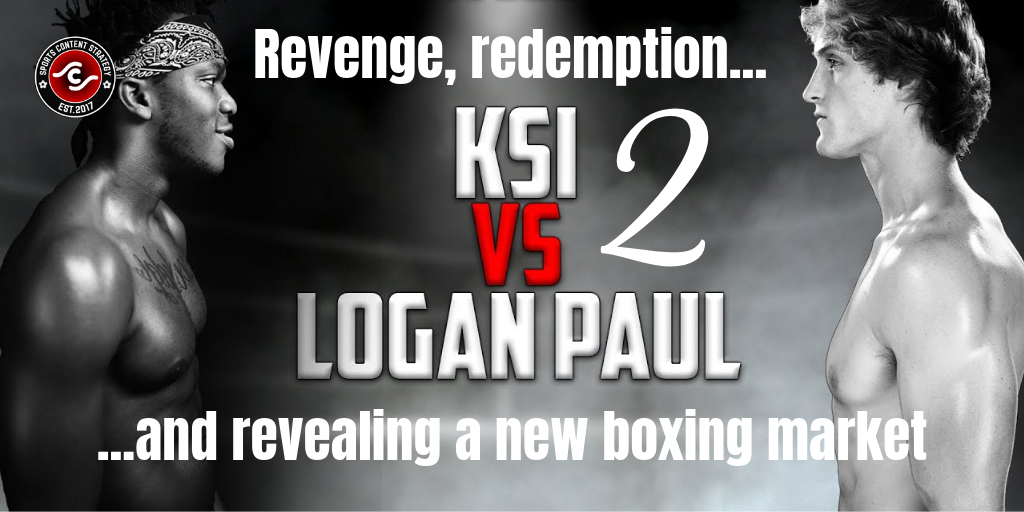KSIvPaul2: Revenge, redemption and revealing a new boxing market
The rematch is on.
KSI v Logan Paul will fight at the Staples Center, Los Angeles on November 9.
It was always going to happen. Their first bout sold out the 20,000-seater Manchester Arena on August 25, 2018, generating an estimated $11m from over 1m pay-per-view buys on YouTube and their respective websites. More than that many watched pirated streams, a reason that was cited for the switch the DAZN this time.
There was hype, bad blood and controversy.
Oh yes, and the result was a draw.
As someone who believes in the nobility of boxing, I was initially appalled by the notion of YouTubers trying to experiment in the sweet but dangerous science of pugilism. Despite protestations of a real ‘beef’ and the YouTube belt(!), the fisticuffs seemed to be merely an excuse to jump aboard a boxing-style bandwagon to hype the event. Such… ahem… banter is their stock-in-trade of course.
The fighting fraternity hated it too. UFC legend Michael Bisping labeled it “insulting to everybody [who] has dedicated their life to being a fighter”.
Gethin Jones, CEO of England Boxing, said it was “a publicity stunt” and “a disservice to the sport of amateur boxing”.
However, the content strategist in me knows the score. Attention is everything and these two manufacture it by the bucketload among the younger demographics. KSI has a YouTube following of 20.4m. He has taken his audience through gaming, comedy, music and sport, each time offering enough value for devotees to splash out. Logan Paul, a Vine star who moved into YouTube and then dabbled in acting, has 19.7m followers. The first fight exceeded expected sales, this one will do multiples of that figure.
It has been enough to the head of Matchroom’s Eddie Hearn, who had previously dismissed taking on such an event. No surprise there, promoters promote when there is money to be made.
The major revelation is that Hearn is considering putting world champion Billy Joe Saunders and rising star Devin Haney on the undercard. By definition, this means they are the lesser attraction. In terms of likes, shares and comments that’s true. But when it comes to the business of jabs, hooks and uppercuts, the two YouTubers will be strictly amateur.
Last week, after boxing fans poured onto message boards in outrage, Hearn was asked by the Behind The Gloves YouTube channel why he had entered the fray. His remarks were like a well-placed jab – hard, straight and right on the nose.
“Because people online have no brain cells at times.
“It's going to fill up the Staples Center and millions of young people are going to be watching it live.
“Are you too much of an idiot to comprehend that or do you just want Devin Haney to box in front of a limited audience of 3000 or 4000 people?
“The reason that I'm even looking at this is because we're idiots if we don't realise it is a chance to bring another audience to boxing.
“Who legitimately sells out big arenas in America? Anthony Joshua did it at Madison Square Garden, but when Vasyl Lomachenko [the current pound-for-pound king] boxed Anthony Crolla, they [only] had 6000 or 7000. If I do this fight at the Staples Center and sell 20,000 tickets, which I will, those 20,000 people are watching Devin Haney too. And over a million people are watching on DAZN in the US and millions [more] are watching it all around the world. You have to spread your horizons, you have to have a brain, right?
“So if I get an opportunity to showcase someone like Devin Haney, maybe even Billy Joe Saunders, to a massive audience of young people who potentially could come into the sport [then I will].
“But,” he added tellingly. “If I get involved with someone like KSI or Logan Paul, certain criteria must be adopted and it's criteria that will shock a lot of people.”
Riding on the coat-tails of YouTubers might be a masterstroke for Saunders, a highly-skilled, fast-moving fighter who has struggled to sell significant tickets despite holding a world title for years.
Just before Christmas 2017, he utterly bamboozled the hard-hitting but robotic David Lemieux in Quebec to retain his WBO middleweight title. After dodging one ill-judged swipe, Saunders stood still in the ring and peered off into the distance as if trying to locate where the Canadian’s punch had landed. Not only was it a perfect GIF, it also summed up Saunders’ stunning execution of his ringcraft.
Eighteen months later, after a failed drugs test and a series of scandals, Saunders regained his WBO title up at super-middleweight with a boring win against a limited German at, of all places, Stevenage FC.
A mega-bucks fight against Canelo Alvarez or Gennady Golovkin was supposedly close before his troubles. Saunders has switched promotional camps, presumably to secure those match-ups now, and Hearn is clearly considering using KSI and Logan Paul to build his profile Stateside. In sporting terms, it is an incredible move but, in digital media, entirely sensible.
British boxing is enjoying a golden age. A string of successful Olympic cycles have laid the foundations. On top of that, you can point to the aggressive matchmaking of Hearn and other promoters, fighters prepared to gamble the prized possession of an unbeaten record, the fit of boxing’s natural promoting skills in modern media and, crucially, a set of blossoming YouTube channels covering every cough and spit pre and post-fight.
It would be too simplistic to bracket IFL TV, Behind the Gloves and Boxing Social with the likes of Arsenal Fan TV, RedmenTV and FullTimeDevils, the leading football fan channels on the platform.
Yes, the output is similar – head-shot interviews, sometimes low on production values, yet always high on authentic, unfiltered opinion. But the boxing channels are talking to promoters and fighters on a regular basis and in dressing rooms straight after fights. They get rumour, opinion and hard news stories straight from the main actors.
Like Arsenal Fan TV, viewing figures for IFL TV videos regularly hit six figures within days, even hours, and key pieces reach 0.5 to 1m. In a world in which Joshua can sell-out Wembley and the Millennium Stadium but Deontay Wilder, until recently his main heavyweight rival, struggles to fill venues a quarter of their size in the US, this daily digital diet must have helped develop the UK boxing audience.
Quite what those US fans potentially buying tickets for Saunders and Haney will make of the main event will be fascinating.
Likewise, it is easy to see the KSI and Paul devotees failing to appreciate the elite skills on show, especially as neither boxer has an eye-catching knockout record at the top level.
Either way, sporting cultures have already started to clash and questions have been raised.
It is not surprising to see boxing take an early plunge given it is the most liberal and unregulated high-level sport in the world. There is no overarching governing body, fighters often have short-term deals with promoters and each event needs to be sold, often via a narrative resting on hyperbole. Or, to look at it another way, it’s always been the wild west with a history full of sports most colourful, shady, downright corrupt characters and you have to sell yourself hard to make money.
Moving slightly wider, I am a little surprised that we have not seen that much crossover between esports and the mainstream. For example, exhibition games between high-profile FIFA players on big screens at major football stadiums, meet-and-greets on the concourses for younger fans, or motor racing sims events between the best virtual and real drivers. Certainly, some have occurred but the coverage has been minimal, though perhaps this says more about those who hold the editorial reigns.
Either way, KSIvPaul2 could be a mini-milestone, an occasion when new-style media stars meet old-style sport head-on.
Of course, WWE could argue that it has straddled this divide for years. And if next year’s relaunched XFL is anything like the first version then it too will ride roughshod over this multi-dimensional terrain.
What’s clear is that the old ties and traditions of sport are breaking down. Football-mad English kids are as likely to wear a Barcelona or Real Madrid shirt than that of their nearest Premier League side, get their football news from YouTube channels not back pages and judge a player on their FIFA stats not their skills on a Saturday afternoon.
Sport is ‘just’ another entertainment now, each fighting for media attention and territory. It is subject to the supply and demand of the attention economy.
You could argue, it is wonderfully well-positioned to profit from the new market, given it retains a unique, visceral ability to stir emotion and pull people along in its narrative wake.
Opportunity is knocking for those with a brave, forward-looking cross-media perspective and Hearn is right to answer the call.




